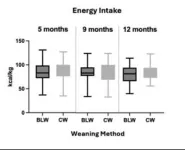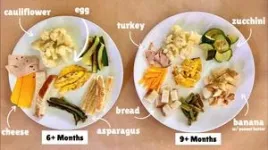(Press-News.org) Chicago (June 30, 2024) — New study findings suggest that baby-led weaning — a popular method for introducing solid foods to infants — furnishes ample calories for growth and development. The findings provide evidence-based support for baby-led weaning, which has not been heavily studied.
Baby-led weaning emphasizes allowing infants to hand feed themselves whole, non-pureed foods when introducing solids to infants versus the more traditional approach of spoon-feeding infants pureed solids. Proponents say that it encourages healthy eating habits because babies self-feed and can explore a variety of foods from the family's meals.
Using data from a large ongoing National Institutes of Health (NIH)-funded clinical study known as the Maternal and Infant Nutrition Trial (MINT), researchers showed that baby-lead weaning provides the same number of calories per kilogram as conventional weaning and may promote higher growth trajectories.
“One major concern with baby-led weaning was that it wasn’t known whether it provided enough nutrients to support infant growth,” said Kinzie Matzeller, a clinical research coordinator and registered dietitian at the University of Colorado Anschutz Medical Campus. “It is reassuring to know that baby-led weaning provides adequate calories for growth.”
Matzeller will present the findings at NUTRITION 2024, the flagship annual meeting of the American Society for Nutrition held June 29–July 2 in Chicago.
The researchers studied baby-led weaning in a subset of 70 healthy, 5-month-old full-term infants from the MINT study, which is examining how different protein-rich foods impact infant growth and gut health. During the study, caregivers recorded three days of the baby’s intake from all foods, including solid foods and breastmilk or formula. These diet records were used to calculate the baby’s daily intake of all nutrients, including calories and macro- and micronutrients.
The researchers classified a baby as following baby-led weaning if less than 10% of their caloric intake came from pureed baby foods. To calculate the calories and protein that the babies were consuming, they measured the babies’ weight, length and head circumference each month.
“Previous studies have relied on self-reporting for classifying baby-led weaning,” said Matzeller. “The fact that we used data from diet records sets our study apart from previous research and may help provide a more universal definition for baby-led weaning, which would help standardize research on the topic.”
Although no significant differences were seen in energy intake (kcal/kg) between the two weaning groups at any point, the analysis revealed that baby-led weaning was associated with a greater increase in weight-for-age and weight-for-length scores than conventionally weaned infants despite similar energy intake. These scores indicate whether a child's weight is considered normal for their age and whether a child's weight matches their height. The researchers note that more research is needed to fully understand the relationship between feeding method, dietary intake and growth.
They also found that mothers with more education and higher incomes were more likely to use baby-led weaning. Although the reason for this wasn’t studied, the researchers speculate that families with higher incomes might more easily afford the time and resources needed for the food preparation required for baby-led weaning and may be more likely to search for or be exposed to alternative weaning methods.
For parents who want to try baby-led weaning, Matzeller recommends following their babies’ cues and staying flexible with food offerings. She adds that it is important to emphasize a varied and diverse diet when introducing solid foods to infants, regardless of how the food is presented.
Soft fruits, steamed vegetables, cheese and small pieces of meat are all good foods to try for baby-led weaning because they are easy for babies to grasp and chew. Foods should be offered as sticks about the size of the baby's fist to prevent choking.
“Baby-led weaning can be a great way to incorporate more options and different types of foods your little one may not get otherwise,” said Matzeller. “It often takes up to 15 exposures to a food before a baby accepts it, so persistence is key.”
The researchers plan to continue this line of study in a larger group of babies as the MINT study continues to enroll more participants. They also want to look closer at potential nutritional differences between the weaning methods such as differences in vitamin and mineral intakes, types of foods and food groups consumed and potential impact on dietary habits as the babies age.
Matzeller will present this research at 10:12-10:24 a.m. CDT on Sunday, June 30, during the Feeding the Future: Infant Feeding Practices session in McCormick Place (abstract; presentation details).
Please note that abstracts presented at NUTRITION 2024 were evaluated and selected by a committee of experts but have not generally undergone the same peer review process required for publication in a scientific journal. As such, the findings presented should be considered preliminary until a peer-reviewed publication is available.
About NUTRITION 2024
NUTRITION 2024 is the flagship meeting of the American Society for Nutrition and the premier educational event for nutritional professionals around the globe. NUTRITION brings together lab scientists, practicing clinicians, population health researchers, and community intervention investigators to identify solutions to today’s greatest nutrition challenges. Our audience also includes rising leaders in the field – undergraduate, graduate, and medical students. NUTRITION 2024 will be held June 29–July 2, 2024 in Chicago. https://nutrition.org/N24 #Nutrition2024
About the American Society for Nutrition (ASN)
ASN is the preeminent professional organization for nutrition research scientists and clinicians around the world. Founded in 1928, the society brings together the top nutrition researchers, medical practitioners, policy makers and industry leaders to advance our knowledge and application of nutrition. ASN publishes four peer-reviewed journals and provides education and professional development opportunities to advance nutrition research, practice, and education. Since 2018, the American Society of Nutrition has presented NUTRITION, the leading global annual meeting for nutrition professionals. http://www.nutrition.org
Find more news briefs from NUTRITION 2024 at: https://www.eurekalert.org/newsroom/nutrition2024/home.
###
END
The desert moss Syntrichia caninervis is a promising candidate for Mars colonization thanks to its extreme ability to tolerate harsh conditions lethal to most life forms. The moss is well known for its ability to tolerate drought conditions, but researchers report June 30 in the journal The Innovation that it can also survive freezing temperatures as low as −196°C, high levels of gamma radiation, and simulated Martian conditions involving these three stressors combined. In all cases, prior dehydration seemed to help the plants cope.
“Our study shows that the environmental resilience ...
Over the past decade, 342 cardiology clinics have been acquired by private equity firms, with over 94% of those occurring between 2021 and 2023, according to a study published today in JACC, the flagship journal of the American College of Cardiology, and presented at the AcademyHealth 2024 Annual Research Meeting in Baltimore. As this practice grows, the study highlights the critical need to monitor the effects of private equity acquisitions on quality of care and outcomes for patients with cardiovascular disease, as well as procedural utilization.
Private equity in health ...
Chicago (June 30, 2024) — A new study found that eating a snack of baby carrots just three times a week significantly increased skin carotenoids in young adults. Levels of these phytonutrients were boosted even more when this healthy snack was combined with a multivitamin containing the carotenoid beta carotene.
Carotenoids, which are responsible for the bright red, orange and yellow colors of many fruits and vegetables, can be measured in the skin to gauge fruit and vegetable consumption since diet is the only source of these pigments. Higher levels of skin carotenoids are associated with increased antioxidant protection and a lower risk of chronic diseases such as heart ...
About The Study: Health care affordability improved for low-income adults during the COVID-19 pandemic, resulting in a narrowing of income-based disparities, while prescription medication affordability improved for all income groups. These findings suggest that the recent unwinding of COVID-19 pandemic–related safety-net policies may worsen health care affordability and widen existing income-based inequities.
Corresponding Author: To contact the corresponding author, Rishi K. Wadhera, M.D., M.P.P., M.Phil., email rwadhera@bidmc.harvard.edu.
To access the embargoed study: Visit our ...
About The Study: Single-payer financing based on the current federal income tax schedule and a payroll tax could substantially increase progressivity of household payments by income. Rate setting led to slight increases in payments by higher-income households, who financed higher payment rates in Medicare and Medicaid. Spending growth targets reduced payments slightly for all households.
Corresponding Author: To contact the corresponding author, Jodi L. Liu, Ph.D., email jodiliu@rand.org.
To access the embargoed ...
About The Study: The first 2 years of the End-Stage Renal Disease Treatment Choices model were not associated with increased use of home dialysis or kidney transplant, nor changes in racial, ethnic, and socioeconomic disparities in these outcomes in this cross-sectional study.
Corresponding Author: To contact the corresponding author, Amal N. Trivedi, M.D., M.P.H., email amal_trivedi@brown.edu.
To access the embargoed study: Visit our For The Media website at this link https://media.jamanetwork.com/
(doi:10.1001/jamahealthforum.2024.2055)
Editor’s Note: Please see the article ...
Ephemeral streams, or those streams that flow only briefly after precipitation events, are a substantial pathway for water transfer with significant implications for water quality, a first-of-its kind study has found.
These streams — which transport water pollutants, sediments, and nutrients from land surfaces to rivers, lakes, reservoirs, and ultimately the oceans — influence a substantial amount of water output of the nation’s rivers, the researchers found. Following a 2023 U.S. Supreme Court decision, however, they are no longer regulated by the Clean Water Act (CWA).
“Our findings show that ephemeral streams ...
Chicago (June 29, 2024) — Findings from a new mouse study suggest that elenolic acid, a natural compound found in olives, can lower blood sugar levels and promote weight loss. The research could pave the way to the development of safe and inexpensive natural products for managing obesity and type 2 diabetes in people.
The researchers found that after just one week, obese mice with diabetes that were given oral elenolic acid weighed significantly less and showed better blood sugar (glucose) regulation than before treatment and compared to control obese mice not ...
Chicago (June 29, 2024) — People with higher intakes of calcium and zinc in the three months before they conceived were significantly less likely to suffer hypertensive disorders during their pregnancy compared with those who had lower intakes of these essential minerals, according to new research.
The results highlight the importance of focusing on nutrition before conceiving — not only during pregnancy — in order to promote healthy pregnancies.
“Our findings underscore the significance of preconception dietary intake of calcium and zinc in potentially reducing the risk of hypertensive disorders of pregnancy,” said ...
About The Study: The results of this survey study indicated that 6 months into unwinding, 1 in 8 Medicaid beneficiaries reported exiting the program, with wide state variation. Roughly half who lost Medicaid coverage became uninsured. Among those moving to new coverage, many experienced coverage gaps. Adults exiting Medicaid reported more challenges accessing care than respondents who remained enrolled.
Corresponding Author: To contact the corresponding author, Adrianna McIntyre, Ph.D., M.P.H., M.P.P., email amcintyre@hsph.harvard.edu.
To access the embargoed study: Visit our For The Media website at this link https://media.jamanetwork.com/
(doi:10.1001/jamahealthforum.2024.2193)
Editor’s ...




